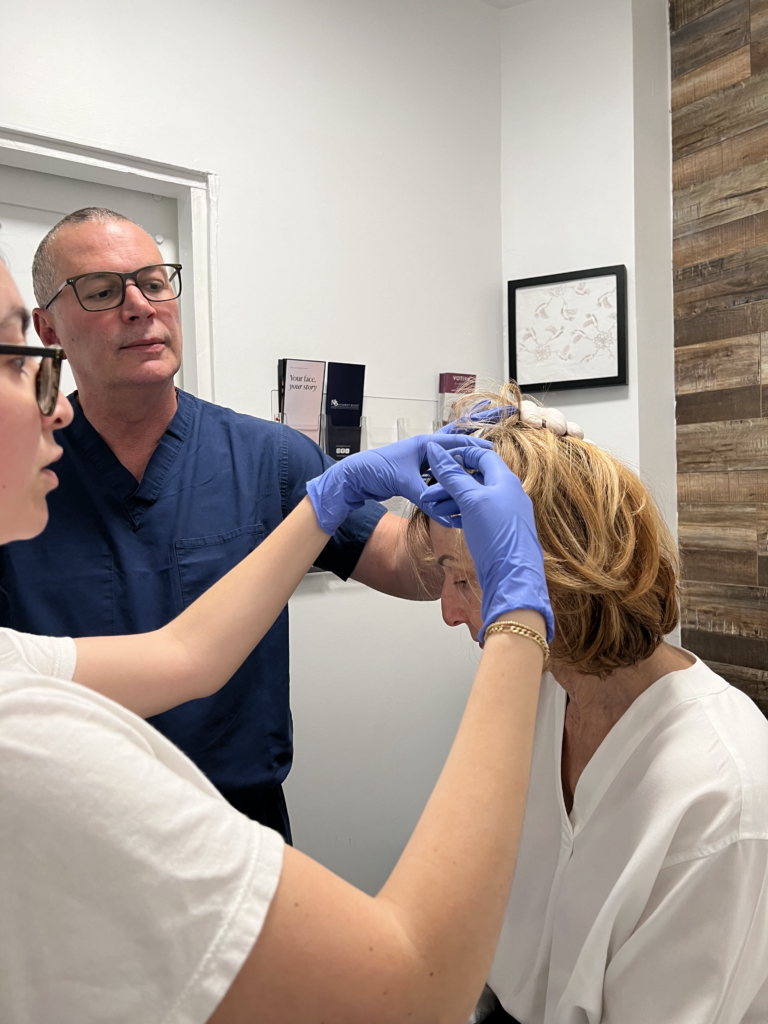Hair Restoration
Our hair is such a huge part of our identity it makes sense that we often panic when it starts to fall out. Both male and female pattern hair loss are often hereditary, although women are more likely to experience hair loss after menopause. And while male pattern baldness usually begins with a receding hairline, women tend to deal with thinning hair that starts on the top and crown of the scalp.
On average, our hair grows at a rate of about ½ inch a month. After growing for two to six years, the hair then falls out and new hair replaces it. When new hair does not appear, that’s when baldness or alopecia occurs. Both female and male pattern baldness are caused by changes in androgens (male hormones) levels. Regulating hair growth is one of the many functions of the androgens.
What Causes Hair Loss
Hair loss is caused by a variety of factors including age, genetics and hormonal imbalances. Male and female pattern hair loss are usually hereditary. Yet, women are more likely to experience post-menopausal hair loss while men experience hair loss at a younger age.
Men tend to begin balding at their hairline, hence a “receding hairline” while women usually experience thinning on the top of the head. When hair falls out and is not replaced with new hair that’s called baldness or alopecia. Men and women start balding when androgen levels begin to fluctuate.
Statistics on Hair Loss:
- More than 35 million men and 21 million women experience hair loss in the U.S.
- Hair loss increases as men and women age
- 80 percent of women 60 and older notice hair loss
- 40 percent of 35-year-old men experience hair loss
- 80 percent of 85-year-old men experience hair loss
- Men and women suffering from hair loss lose an average of 100 hairs daily
Why Does Platelet-Rich Plasma Therapy (PRP) Work?
The platelets are injected into the scalp in the areas that are thinning or starting to thin. Platelets are natural healers, they help repair the blood vessels and cells. That’s why the medical field has started to successfully use this treatment for a variety of disorders. The fact that this therapy helps heal wounds faster, is the same concept applied to hair loss: PRP encourages tissue regeneration and growth. Introducing platelets to the areas where the hair follicles are damaged increases blood flow and encourages new vessel formation, which in turn helps stimulate hair growth.
By injecting these tiny “messengers” into the scalp, the dormant hair is essentially told to start growing again.
PRP Helps Hair Grow:
- The platelets increase blood supply to the hair follicle.
- The treatment increases the thickness of each piece of hair.
- Continual treatment helps maintain the growth and thickness.
- Platelet injections will diminish hair loss.
What Should I Expect During my Appointment?
The entire treatment is relatively quick with no downtime and minimal discomfort. Most of our patients will have a complete treatment in under 30 to 45 minutes. While there is no recovery time involved, patients are advised against using any harsh chemicals on their hair for the 48 hours following treatment.
When Will I See Results?
Patients should begin seeing results within 5 to 6 months. Results don’t last forever. It’s recommended that patients maintain by scheduling treatments two to four times annually. While results vary, most patients report an 80% success rate.
Is PRP for Hair Regrowth for You?
Receiving an accurate diagnosis and formulating a treatment plan is essential. Talk to your physician about your issues and the two of you will be able to decide the best course of action to treat your hair loss.
Dr. Ghozland is an experienced physician devoted to helping patients look and feel better using non-surgical treatments such as PRP. To schedule a free consultation, or to learn more about his services, call Dr. Ghozland’s Los Angeles office at (310) 393-9359 or schedule an appointment here.


